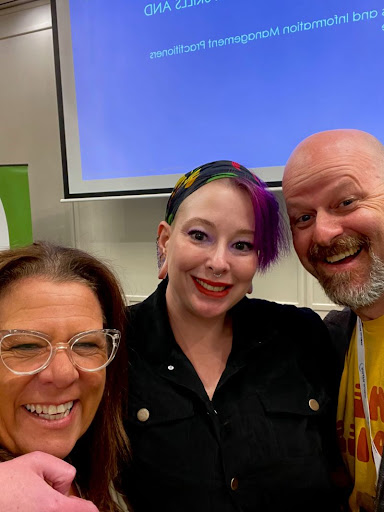When I was asked to present at the Records and Information Management Professionals Association (RIMPA) roadshow in Western Australia recently, I did not expect to be sitting on a panel discussion about the future of records management after a torrid night spent trying to get some sleep on the floor of the Kalgoorlie airport, along with 130-odd other people.
That story begins in Brisbane, where I was helping with some workshops with our client, the Queensland State Archives. Our team are heading into the first milestone for the new Digital Preservation System there, and so we were planning the next stage of the project to deliver the final touches on the system. After a good collaborative day of workshops, I climbed aboard a flight back to Perth, and found our flight firstly diverted to Kalgoorlie with a fuel issue, and then unable to finish the final leg of the journey due to a maintenance issue. And so, there we were, 130-odd passengers, trying to find a way to sleep on the Kalgoorlie airport floor.
When we did arrive back in Perth, I realised that there really was no time to rush home to get changed into something more formal for my presentation, and instead headed to the RIMPA event wearing my plane clothes to present on the topic of “Preparing for the Future; Skills and Technologies”.
When I’m asked to present at an event, I like to do my homework into the people that are there and to try to come up with something that is useful for them to take away and use themselves. I think it’s beholden on a presenter to make sure that their presentation is useful (and bonus if it’s also entertaining, which I do strive for).
In this case, I set up my presentation to look at where we are at today (including an explanation of my attire), where “here” really is, how you assess your baseline in terms of the skills and technologies you have before launching into a crystal ball gazing session about what Records Management professionals might need into the future. To do this, I introduced them to a model we’ve worked with many times in our environment area; our model we use for assessing the health of an organisation across some key areas; people, process, data, hardware and software. We started using this model across spatial health check projects, but we find that it works for other industries as well.
This model opens the door for an evaluation of some of the trends that are out there in each of those areas, and I highlighted the following in my talk
- People – it’s about “soft skills”, mental health strategies and resilience
- Data – looking at the full data lifecycle means you have to consider the volumes being created, the environmental cost of storing all this data, Artificial Intelligence (AI) and security considerations,
- Hardware – it’s about location – is your hardware in the cloud (i.e. someone else’s data centre, or your own on premise approach),
- Software – thinking about the life cycle of software and the 7-10 year lifespan of software, as well as the increasing opportunities that AI is bringing to the field, and
- Process – it’s about making sure you are developing the best practice processes that work on the digital side, not ones that are just converted from analysis projects.
When you put all this together, you end up creating a plan to evaluate your organisation – one that takes this strategic review as the first step, before moving into process creation, staff development and training, and potentially system implementation for the next generation of system for your organisation. By following that plan you can go on a journey from where you are to somewhere in the future you really want to be (and hopefully you don’t get diverted to Kalgoorlie along the way – but make the most of it if you do!).
It’s important in any organisation considering any sort of approach to really look at where you have come from, and what you have before you embark into the future. I feel like this is something in particular that I’ve been learning about Gaia Resources over the 20-odd years and multiple evolutions that we have been through, and I hope that it was of use to the RIMPA attendees on the day.
While I can’t promise that I will never turn up to a presentation wearing a Goodies t-shirt in the future, I can promise that I’d be back to another RIMPA event like this in a flash – the audience were very well engaged and it was a real privilege to be there.
If you’d like to know more about how these sorts of plans work for organisations, get a copy of the presentation, or just want to follow up on something I’ve said on the day, then drop me a line at piers.higgs@archive.gaiaresources.com.au. You can also always start a conversation with us on our social media feeds Twitter, LinkedIn or Facebook, and it’ll get to me that way, too!
Piers




Comments are closed.